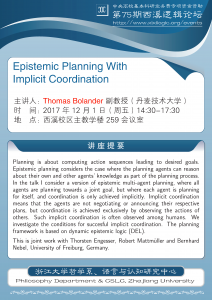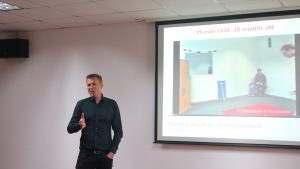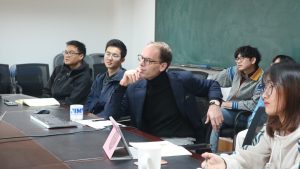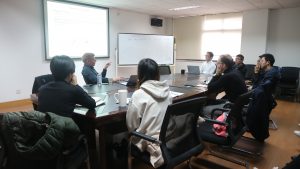Thomas Bolander: Epistemic Planning With Implicit Coordination [2017-12-1]
Speaker: Thomas Bolander (Technical University of Denmark)
Date & Time: 1 December 2017 (Friday), 14:30 – 17:30
Place: Room 259, Main Teaching Building, Zhejiang University
Title: Epistemic Planning With Implicit Coordination
Abstract:
Automated planning is a branch of artificial intelligence concerned with computing plans (sequences of actions) leading to some desired goal. An agent (human or robot) could e.g. have the goal of picking up a parcel at the postal office, and then the problem becomes to find a succesful sequence of actions achieving this. Epistemic planning is the enrichment of planning with epistemic notions, that is, knowledge and beliefs. The agent might have to reason about epistemic aspects such as: Do I know at which postal office the parcel is? If not, who would be relevant to ask? Maybe the parcel is a birthday present for my daughter, and I want to ensure that she doesn’t get to know, and have to plan my actions accordingly.
Dynamic epistemic logic (DEL) offers a very expressive formal framework for epistemic planning. In the talk, I will present a version of DEL-based epistemic planning in which a group of agents are individually planning towards a joint goal, and where coordination is only achieved implicitly. Implicit coordination means that the agents are not negotiating or announcing their respective plans, but coordination is achieved exclusively by observing the actions of others (including announcement actions). Such implicit coordination is often observed among humans collaborating to achieve a joint goal. We investigate the conditions under which the goal can be guaranteed to be reached by implicitly coordinating agents.
This is joint work with Thorsten Engesser, Robert Mattmüller and Bernhard Nebel.
会后报道:
2017年12月1日下午,第75期 “西溪逻辑论坛”邀请的主讲人是丹麦技术大学(DTU)应用数学和计算机科学的副教授Thomas Bolander。他的研究领域是逻辑与人工智能,主要侧重于使用逻辑来刻画具有社会性的人工智能,使得机器灵活地适应社会场景。Bolander本次报告的主题是“内隐协调的认知规划”,他首先明确的提出了研究的问题,并详细定义了涉及到的基本概念和方法;其次在动态认知逻辑的基础上建构基本的协调认知模型和更新规则,在此基础上扩展为内隐协调的认知规划模型,并修正了更新规则。在报告中他提出内隐协调是指多个主体基于共同目标的前提,通过观察其他人的行为(包括暗示、宣告等)对自己和他人的行动进行隐含的推理过程,而不涉及直接的协商讨论等行动。这种协调方式与经典的、由公共知识(common knowledge)所刻画的协调方式不同,它通过将所有可能的沟通直接建模为可规划的行为,并依靠自主性主体视角转变的能力,更加合理的解决多主体之间的内隐协调问题。多主体系统的重要任务是多个自主性主体合作实现一个联合目标(joint goal),在每一个任务中,每个主体不仅需要推理自己的行动,也需要推理其他主体的有助于达成目标的行动。
Bolander基于动态认知逻辑(DEL)提出了内隐协调的认知规划框架。首先他在经典框架基础上给出了一种新的动态公式(a)φ:它表示若一类动作a可应用(applicable),则φ成立。同时他用积更新来具体表示当某一类动作应用在当前状态后产生的后继状态。其次,为了进一步刻画多主体之间的协调规划任务,他引入ω(a)来表示执行动作a的主体,通过这种方式定义的每一个动作都有唯一的执行主体。再次,他提出协调规划的最简单的解决方案可以表示为一系列动作的有序序列 (a1, . . . ,an)(标准序列规划),其中要求在初始状态上执行的每个动作都必须是可应用的,并使得最终状态满足目标。最终,在此基础上,他递归定义了内隐协调序列 (a1, . . . ,an),其中ω(a1)必须知道a1是可应用的,并且可以确保 (a2, . . . ,an) 也是内隐协调序列。换句话说,ω(a1)知道当a1 被执行后,可以确保ω(a2)知道动作a2 是可以应用的,并且在执行了动作a2之后有助于最终目标的实现,后续的动作执行者也满足此要求。
对本次报告的评价,从报告人来看,Bolander表达风趣幽默,过程中结合生动的案例分析,不仅清晰地阐述了报告的内容,而且十分注重和同学们的交流,对在座的同学来说具有很大的启发性,是一场非常精彩的报告;从现场气氛来看,在报告过程中,同学和老师都积极的参与了讨论,争相发表自己的想法,氛围非常自由;从获益程度来看,本次报告的受众面比较广,大部分同学都可以有较好的收获,一方面是逻辑方法的正确应用,另一方面是研究的创新性,都有值得我们学习的地方。
(杭颖颖 报道)






